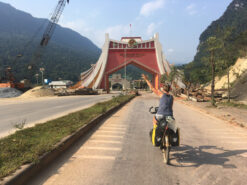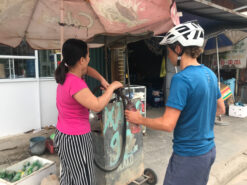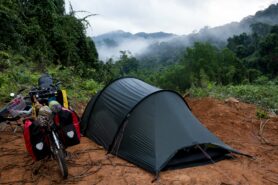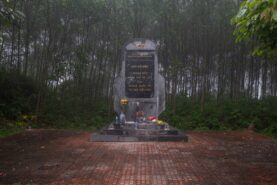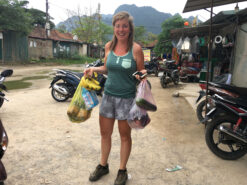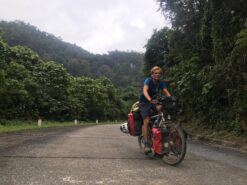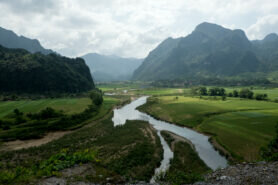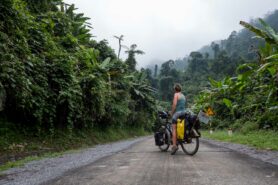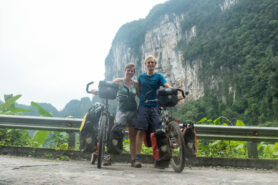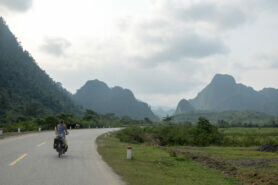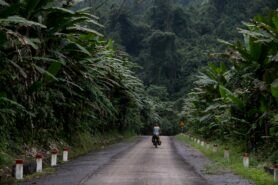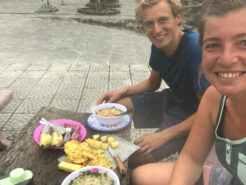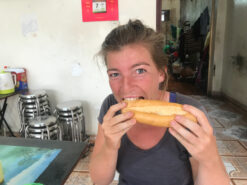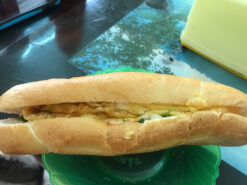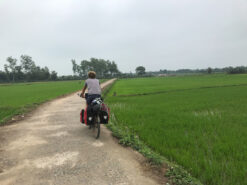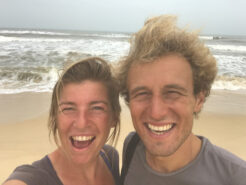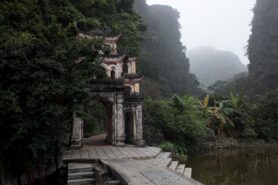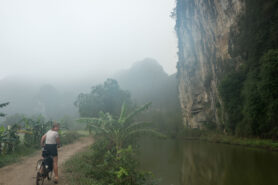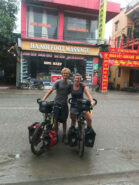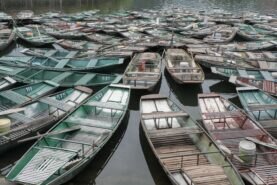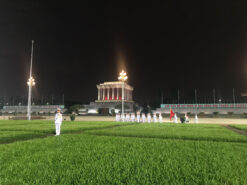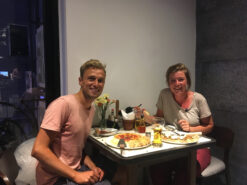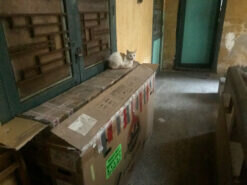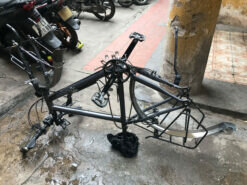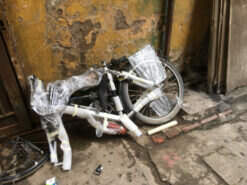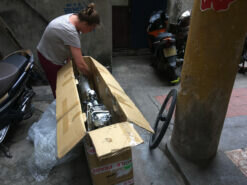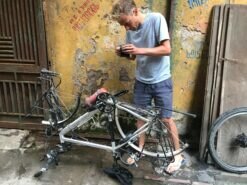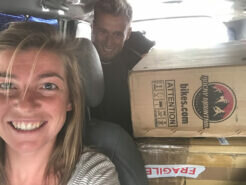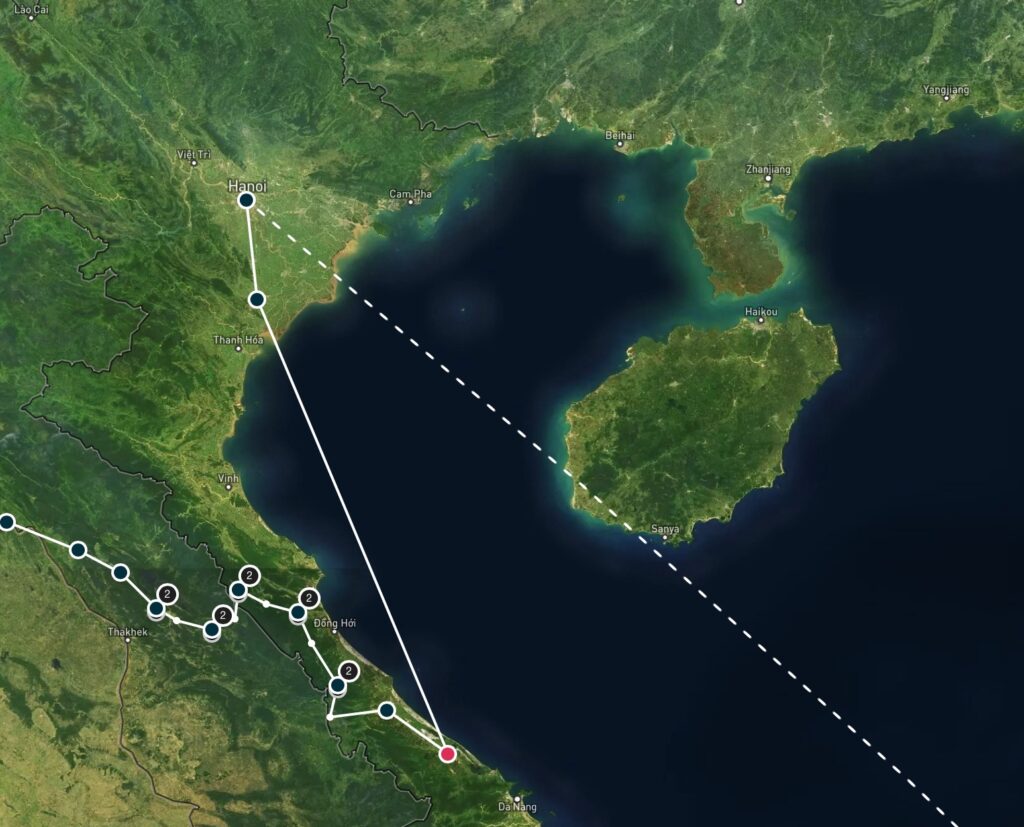Phong Nha (VN) – Hanoi (VN) / 17137 km / 8.35 Million Turns / February 3rd – February 17th, 2020
ă, ằ, ầ, ấ, ẵ, ẫ, ẳ, ẩ. The Vietnamese alphabet looked quite similar at first, but after some trying it turned out hopeless. Yes, all the letters ‘a’ above have a different pronunciation and although it looks readable, looks can be (very) deceiving.
Still, the border post fortunately had some English written down, to welcome any non-Vietnamese travellers. Not that there were many though, as we chose one of the most remote borders out there; the nearest supermarket, ATM and town were still 90 km away. We were glad that the border cross went relatively smoothly; Vietnam’s visa procedure was quite strict as we had noticed with the delay in approval a few weeks ago. The (back then still very premature) coronavirus situation did work a bit on the nerves of the Vietnamese customs officials. Lao officials didn’t care at all, but suddenly we were surrounded for the first time by facemasks. But since it’s Asia, that might not be such a weird thing after all, we thought….
There are two ‘popular’ cycle routes in Vietnam, both of which we wanted to do very dearly but unfortunately there was only time to do one. As such, we left the Avatar country of the Northern Ha Giang Loop for what it was and continued on the more historic road right through Vietnam’s heartland, The Ho Chi Minh Road. It was built after the Vietnam War (or the ‘American War’ as it’s called in Vietnam) as commemoration to the Ho Chi Minh trail, a jungle trail which supplied the Vietcong army in South Vietnam with equipment and manpower. Now, where the trail has been reclaimed by the forest mostly, you can ride several sections on a fully sealed road.
The first town we reached was Phong Nha. Up to a few years ago, this was a tiny settlement mostly living off agriculture and fishing. In 2009 a team of National Geographic discovered the largest cave in the world in the vicinity of this town. This cave is so large it even has its own forest inside it, together with self-producing clouds and precipitation! Although many smaller caves were already discovered, being the base for ‘the largest cave in the world’, drew so many tourists that it is now firmly set on the itinerary of many backpackers in Vietnam. The rampant building of hostels, hotels, food shacks and even a Hollywoodesque sign on the top of the hill all made it feel pretty tacky and again started the internal debate on (mass)tourism, the snap-and-go mentality of many visitors and the lack of environmental and social sustainability of such means of income. Although we are conscious that we are also participants in the tourism circus, we often felt quite detached of the rest of the backpacker culture. Or maybe we are just getting old and grumpy…
Finding quick bites and restaurants in Phong Nha is easy, but finding ‘normal’ food for a couple of days riding a little harder. Things like pasta, dried noodles, vegetables and oats were nowhere to be found in supermarkets here. After some asking around, we ended up just outside of town at the local market, which is the best bet for finding fresh veggies anywhere in SE Asia. Stocked up with food for at least 5 days we started our ride into the mountains, along the Ho Chi Minh road. The jungle rose up over towering walls of limestone cliffs and soon we felt as if completely alone on the world. This section of the HCM road doesn’t really connect any towns so it’s barely used by local people, so if there were any passers-by, it were mostly other tourists on motorbikes (and the occasional cyclist even). The rhythmic ‘tud-dud’ every 3 m of the concrete slabs lining the road gave it an almost meditative atmosphere.
We could see why so many people recommended this section of the HCM road. Not only could you still see many remnants of its importance in the war and as such create some awareness on the history of this place, it was also a simply stunning natural scenery. Although we didn’t pass by the world’s largest cave directly, there were still huge ones just by the side of the road, some with a gaping hole of 200 m high. Birdsong, misty clouds rolling through the mountaintops and a complete lack of any house or settlement for 80 km made it a unique part of the trip.
The first village would be a good time for a lunch break we thought, but we were warned by a German cyclist coming the other way that he and other foreigners were rudely denied entry in any shop or hotel by the locals. Apparently, news of the coronavirus situation in China had also reached to this remote area in Vietnam. Locals were extremely scared that one of these tourists might be carrying coronavirus. Note that this was early February and almost everyone thought quite reluctantly that it was more of a Chinese issue only. Our facemasks given as a complimentary gift when buying a SIM card now came in quite handy to ease the worries of the local villagers, although we found (back then) people were being a bit paranoid. When wearing these, we were let into some shops and a little restaurant. Weeks later, we heard quite some stories on xenophobia in Vietnam geared towards foreigners, who were rounded up by the police and threatened to be put into ‘quarantine facilities’ or urged to get on the first flight out back home. We could understand the fear partly, these places have little to no facilities or resources to combat a pandemic. But it didn’t make us feel very welcome. Fortunately, as we had our tent and enough food, we were self-sufficient and could cycle through most of the villages without much issues.
This was not the only incident related to coronavirus though. Over the next few days, we noticed a few kids cycling the other way were covering their mouths while passing us by. Some local village men would sign an “X” with their arms to us, indicating to not come close to us or would shush us away. It was a bizarre realisation to see all this fear directed at us and, to be honest, made us realise what a fine balance trust is and how vulnerable you are on a bicycle.
Foodwise, Vietnam was a definite hit or miss country. In some areas, you had wonderfully nice and cheap eats, such as Chay (vegetarian buffet), Banh Mi (baguette with spread and egg) or spring rolls. But, if you find yourself in the wrong place, you might get served boiled intestine stew. So for some occasions, it’s definitely worthwhile to know your ‘luong’ (fish or eel) from your ‘long’ (intestines) to not get a plate of cow’s bowels on your plate. Apart from that, timing was an issue too. We had difficulty finding places that would serve food around lunch time. It was only after a few days that we realized that Vietnamese restaurants are generally closed between 11 AM and around 3-4 PM. We had to adjust our meal times if we wanted to have lunch at a restaurant. Our favourite was the Bahn Mi, a French style baguette with all kind of spreads and omelette.
After a few extremely hilly but stunning few days, we left the Ho Chi Minh road at Khe Sanh, turning our compass towards the coast. Almost 11 months after we had left the North Sea in Holland behind, we now met the sea on the eastern side of Eurasia! A milestone and we felt we could claim to have crossed this giant landmass overland and (nearly completely) human powered. Sadly, the sea wasn’t the tropical bounty island sea we had hoped, but actually more resembled our grey and windy North Sea. Still, it was a moment to remember. A little further south along the coast, in Hue, we took the bus up north, to be in time for our flight. After brief stopover in Tam Coc, in many ways a copy of Phong Nha (limestone, caves, paddies, mass mass mass-tourism), we reached the capital, Hanoi! This was to be our final stop on the Eurasian continent.
While there, Tom got a message from Rens, a former schoolmate who has been living in Hanoi for several years and was following our journey via Instagram. It resulted in a surprising and unexpected reunion, with a tour along Hanoi’s known and unknown hotspots, such as a local craft beer café at the lake, a vegetarian all-you-can-eat buffet (Chay) and a cocktailbar that even made CNN headlines (when Trump and Kim Jong Un met last year in Hanoi for their summit, they created the ‘Rock-it-Man’ cocktail; a mixture of American bourbon and Korean Soju. In true Vietnamese spirit, the second-to-last night was spent at the mausoleum of Ho Chi Minh or for Vietnamese “Uncle Ho”, where we discussed his legacy with several young Vietnamese people. The last night was spent in even better Vietnamese fashion in an Italian fusion pizza bar ;).
Then, on February 17th, the day arrived we’d be flying off instead of cycling off to our next destination: Australia, a country/continent we’d never been to and were looking forward to see (think kangaroos, surf, exploring Melbourne and meeting old friends). But first, we had to solve the logistic puzzle every cycle tourer will face when boarding an airplane. How to get that darn large bike on a plane? One might argue someone could do a PhD on aeroplane and bicycle travel because it did take some tedious logistic puzzling. Here’s a brief breakdown, if any of you are planning to go.
Step 1: Find yourself a cardboard box to put your bike in.
Often solved by visiting a local bike shop, or in our case, our Warmshowers host just happens to have two lying around in his house. Perfect, Step 1 solved.
Step 2: Get a pedal wrench.
The pedals have to be removed in order to get the bike into the box. However, they are often so tight after many thousands of km that you’ll need a big lever or Allen key to exert the force to loosen them up. Fortunately, Hanoi’s shops are distributed in what we call, ‘The Asian way’. Instead of spreading out, all similar shops are grouped together. As such, there is a street with sewing equipment, a street with shoemakers, a street with packaging material, and yes, also a street with iron tools. After crawling through alleyways, we found the long 6 mm Allen key we needed.
Step 3: Get bubbling wrap to protect your bike from the airport baggage handling hell.
Hey, wait a minute, didn’t we just pass the packaging material street? A quick ride back and we’re loaded with 10 m of bubble wrap! Other options are heading up to Decathlon/household appliance stores and ask for wrapping material.
Step 4: Pack it all in a box.
Seems simple, is not. The bike box is most likely for a different size bike then yours, so good luck fiddling everything in. And don’t mind the rat that races over your feet while packing, it is Hanoi after all!
Step 5: Get the box to the airport.
Normally a bike is quite useful to get somewhere, except when it’s in a box. And yes, there are buses, but how do you get the 20+ kg box from your place to the nearest bus station? You can drag it, but what about the panniers? Leave them at the station? Hmm, difficult.. We surrendered and ordered a 7 seater big ass taxi, it was worth the €15,- fare.
Step 6: Wrap all your panniers in cling film.
Just as your bikes, you’ll want to give your panniers some extra protection. We wrapped them together in cling film so you’ll have less parcels to check in, meaning less can get missing in transit. A layer of packing/duct tape over the cling film will give it its final touch.
Step 7: Beat the scale and airline excess baggage fee.
You always end up with more kg than you presume. Even the cardboard box itself is 5 kg or so. In the end, we booked 10 kg extra, meaning we had 30+10 = 40 kg a person, and we checked in 39.9 kg and 39.8 kg each. If you think that was all our stuff, we also had a full pannier as cabin baggage, and wore three sets of clothes over each other. If you ever have some hours to spend on an airport of a tropical country, try and see if you can pick out any person walking in a big down jacket and with every pocket filled. Most likely it’s a long-distance cyclist 😉
Step 8: Check in, sit back, relax and enjoy the flight!
Talk to you soon!
Tom & Sabine


